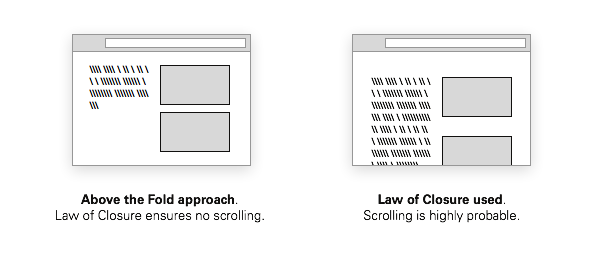Above the fold in web design is a rule of thumb that often appears in discussions, mostly about home pages and landing pages, and implies that the region of the page that is visible in the window from the start without scrolling gets viewed the most. Depending on the study you see, the amount of people that doesn’t scroll can be as high as 77% (2006, Jackob Nielsen) or as low as 24% (2006, Arik & Tal).
For me, that’s a case where a wonderful metaphor was inherited from print (the fold in print identifies the portion of the paper that is visible on newsstand, thus a huge sales driver) and was adapted to the web missing the underlying principle driving it. Because digital is a different medium, and the “fold” has very different implications.
The foundation of the above the fold rule is simple: the Law of Closure from the Gestalt psychology studies.
Law of Closure
Our mind will try to complete an incomplete visual stimulus to increase regularity. We perceive incomplete objects as whole, our mind fills the gaps.

- If we partially hide an object where the fold is, the user will naturally be driven to scroll the page down.
- If I work with the idea that the fold rule exists I’m actually ensuring that people won’t scroll.
- The Law of Closure tells us why people will scroll: to complete an incomplete stimulus. More content is expected to follow.
This means that “Above the Fold” is a self-satisfying rule, not a principle.
If you want more data about this:
- Everybody Scrolls, by Rebecca Gordon: 91-100% of the users scroll.
Thanks to Francesco Rapacciuolo for the conversation starter.